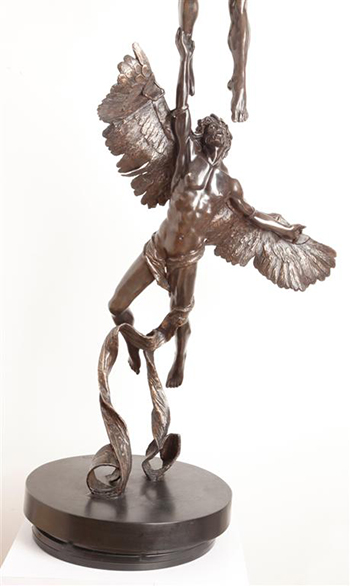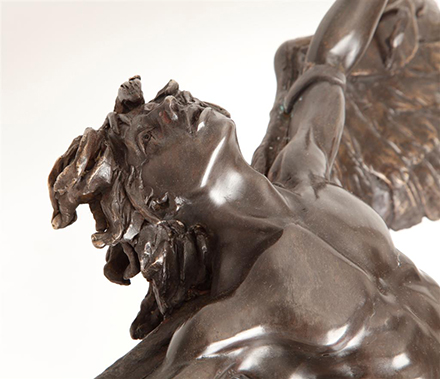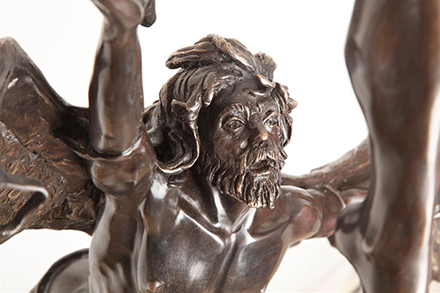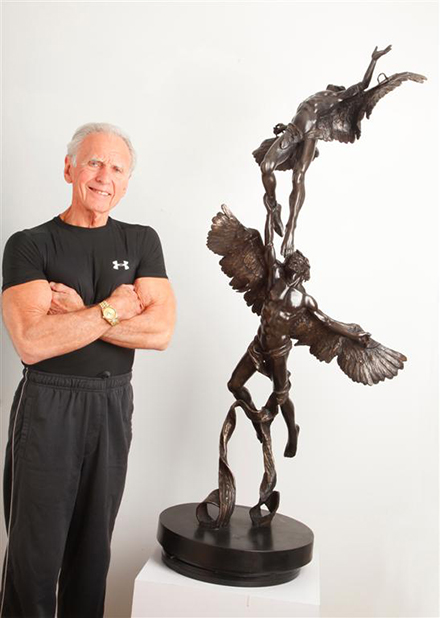 home
about
artists
exhibitions
press
contact
purchase
home
about
artists
exhibitions
press
contact
purchase |
|||||||
|
RICHARD L. MINNS Tall bronze on
circular base CLASSICAL MYTHOLOGY MAN’S FIRST FLIGHT. The famous Greek inventor, Daedalus, and his son, Icarus, were captive in the unroofed Labyrinth. Since their only means of escape was by air, Daedalus made two pairs of wings out of feathers and wax. He told Icarus neither to fly too near the sun, which would melt the wax, nor too close to the sea, which would wet the feathers. But Icarus, exalting in the freedom of the air, forgot his wise father’s words and flew ever higher, until the sun melted the wax and he plummeted to his death in the sea below. The Icarian Sea, where he fell, was named after him.
SCULPTURE’S DESCRIPTION Icarus is at the top, exhilarated with his ability to fly, and he is flying straight for the sun … and his doom. His father, Daedalus, is flying safely below, right arm outstretched high, holding his son’s ankle, attempting (in vain) to restrain him. Actually, Flying Too High (Daedalus and Icarus), where Icarus is flying straight for the sun and his father Daedalus is frantically trying to restrain him, is a companion sculpture to Icarus’ Final Moment, where Icarus (in mid-air), is about to crash into the sea, his body contorted in perfect Greek Pathos, his melted wings hanging limply under him. This sculpture is first a masterpiece in engineering and architecture. In order to show Dadealus and Icarus soaring high in the air and to create the illusion of defying gravity, Daedalus is flying in one direction and Icarus is flying in the opposite direction, creating a horizontal “V” shape so that the center of gravity is perpendicular to the center of the two bodies allowing the sculpture to stand solid and firm, but clearly giving the illusion of defying gravity … and FLIGHT! The relationship of the bodies of Daedalus and Icarus has maximum grace and fluidity of form, expressing power, emotion, conflict and maximum movement. It is a beautiful ballet of forms in the air. The expression on Daedalus’ face, anguish and concern over the fate of his disobedient son, is in contrast to the expression on Icarus’ face, exhilaration and rapture in his freedom of being able to fly. This is the original prodigal son story. The surface modeling is vintage Richard Minns at his best. No detail is overlooked … from Daedalus’ windblown hair … to Icarus’ wild hair covering his left eye … to every feather on their wings … to the stirrups which hold the wings to their arms. Nothing misses Richard’s watchful eyes. This sculpture LIVES! ARTIST’S
INTERPRETATION I made their bodes long (almost 9 heads to the body) to give them the grace, motion and fluidity of ballet dancers in the air. My goal is to create maximum emotion and maximum movement … make my creations come ALIVE. If you feel that I accomplished this goal, then my sculpture is a success. I hope that you enjoy this sculpture half as much as I enjoyed creating it.” Richard L. Minns
|
|||||||
|
|
|||||||






